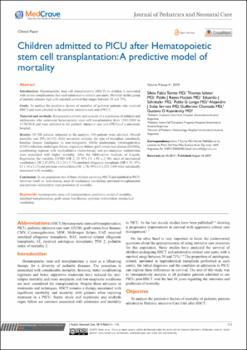Children admitted to PICU after hematopoietic stem cell transplantation: A predictive model of mortality.

View/
Date
2019-08-16Author
Torres, Silvio.
Ioister, Thomas.
Reyes, Pablo.
Schnitzler, Eduardo.
Longo, Pablo.
Siaba, Alejandro.
Chantada, Gustavo.
et al.
Metadata
Show full item recordAbstract
Abstract
Introduction: Hematopoietic stem cell transplantation (HSCT) in children is associated
with severe complications that need admission to critical care units. Mortality in this group
of patients remains high with reported survival that ranges between 38 and 71%.
Goals: To analyze the predictive factors of mortality of pediatric patients who received
HSCT and were admitted to the pediatric intensive care unit (PICU)
Material and methods: Retrospective review and analysis of a population of children and
adolescents who underwent hematopoietic stem cell transplantation from 12/01/2008 to
11/30/2018 and were admitted to the pediatric intensive care unit (PICU) of a university
hospital.
Results: Of 248 patients subjected to the analysis, 109 patients were admitted. Overall
mortality was 29% (n=32). After univariate analysis, the type of transplant (unrelated),
baseline disease (malignant vs non-malignant), febrile neutropenia, cytomegalovirus
(CMV) infection, multiorgan failure, respiratory failure, graft versus host disease (GVHD),
conditioning regimen with myeloablative chemotherapy and pre-transplant malnutrition
were associated with higher mortality. After the Multivariate Analysis of Logistic
Regression, the variables GVHD (OR 2, 23 95% CI: 1.92 a 2, 98), need of mechanical
ventilation ( OR 2.47,95% CI 1.39 a 5.73) unrelated allogeneic transplants (OR 1.58, 95%
CI 1.14 a 2.17) and previous malnutrition (OR: 1.78, 95% CI 1,223-3.89) were statistically
associated with mortality.
Conclusion: In our population two of three children receiving HSCT and admitted to PICU
survived. Graft vs. host disease, need of mechanical ventilation, unrelated transplantation
and previous malnutrition were predictors of mortality

